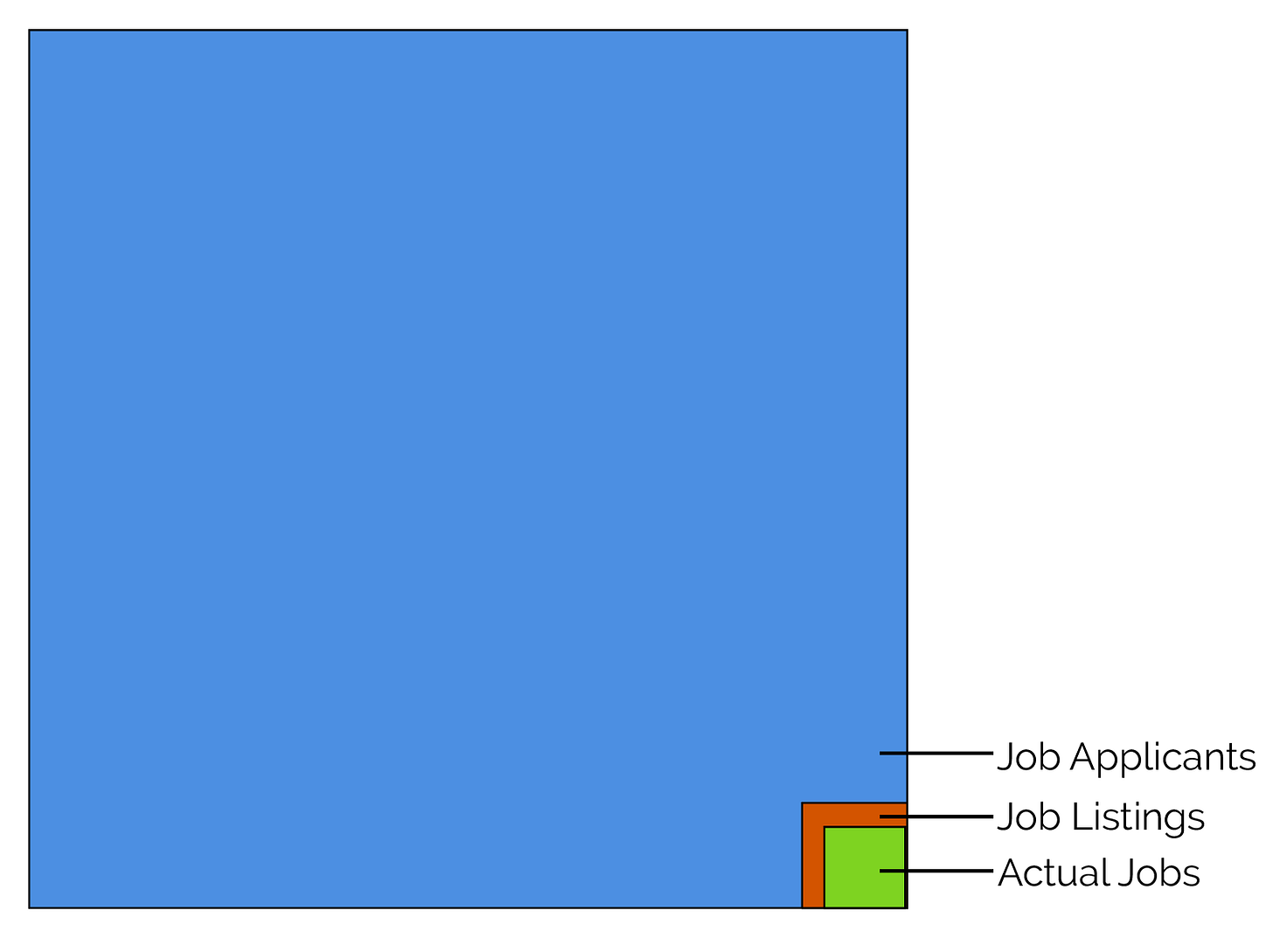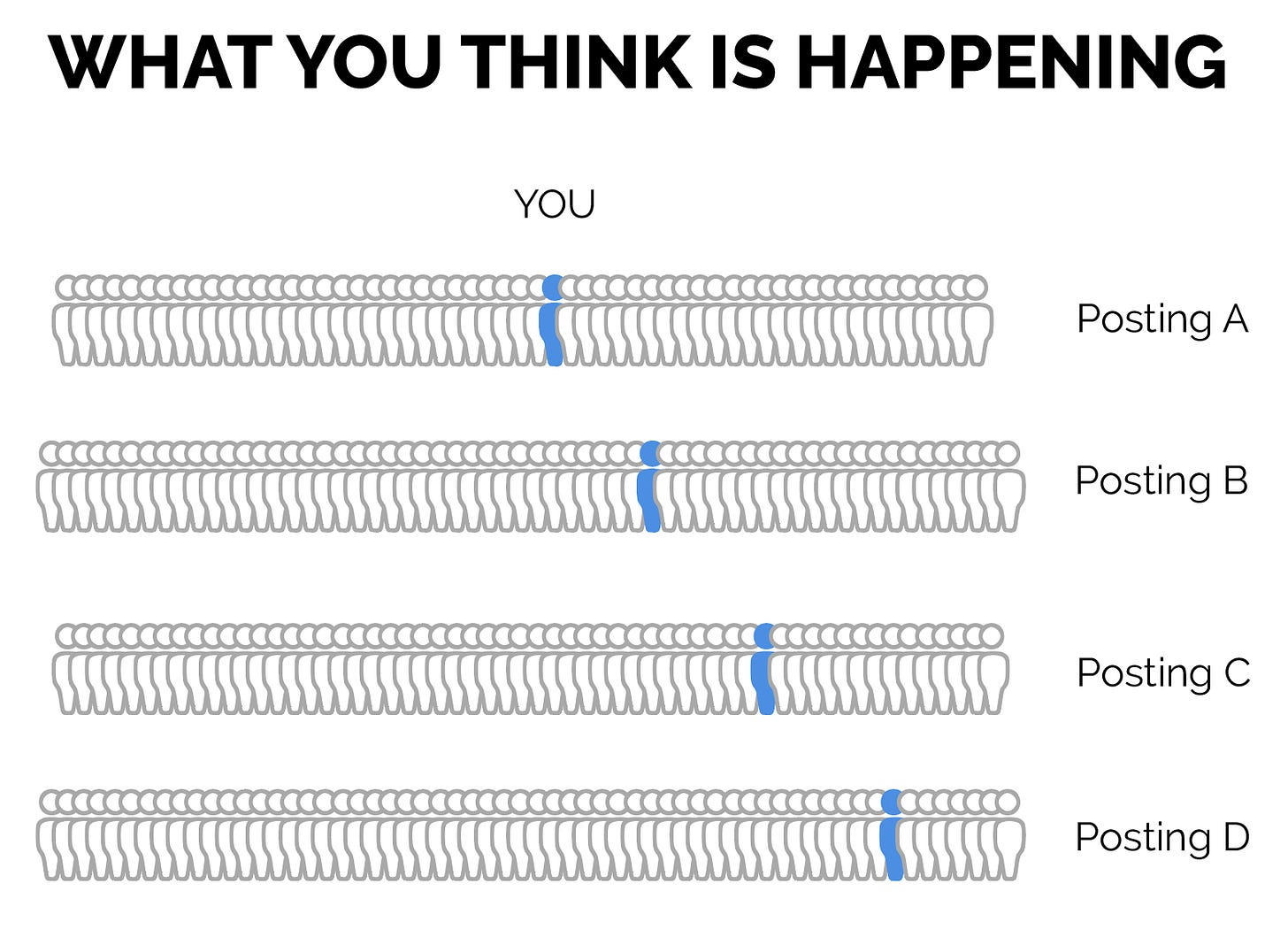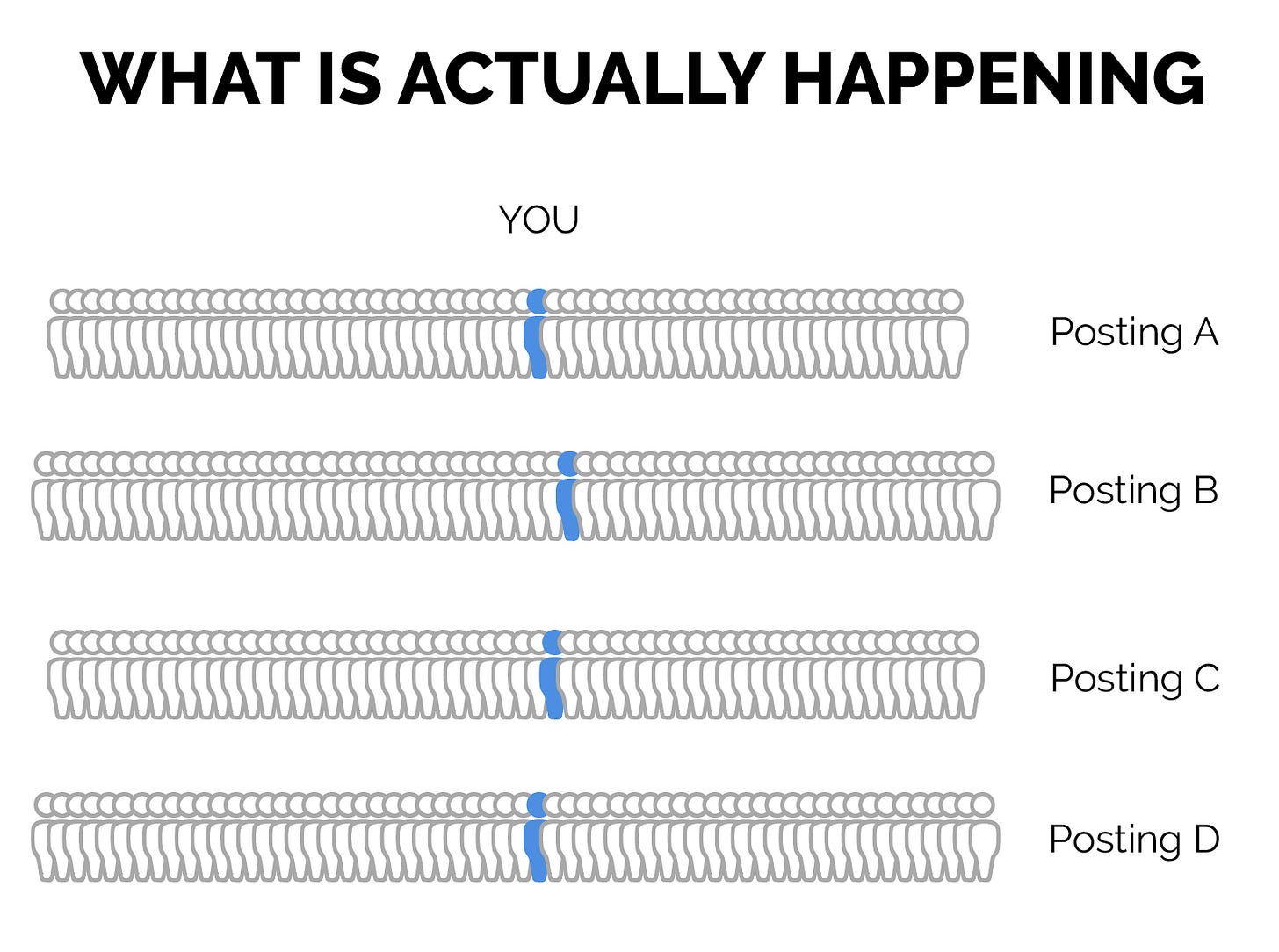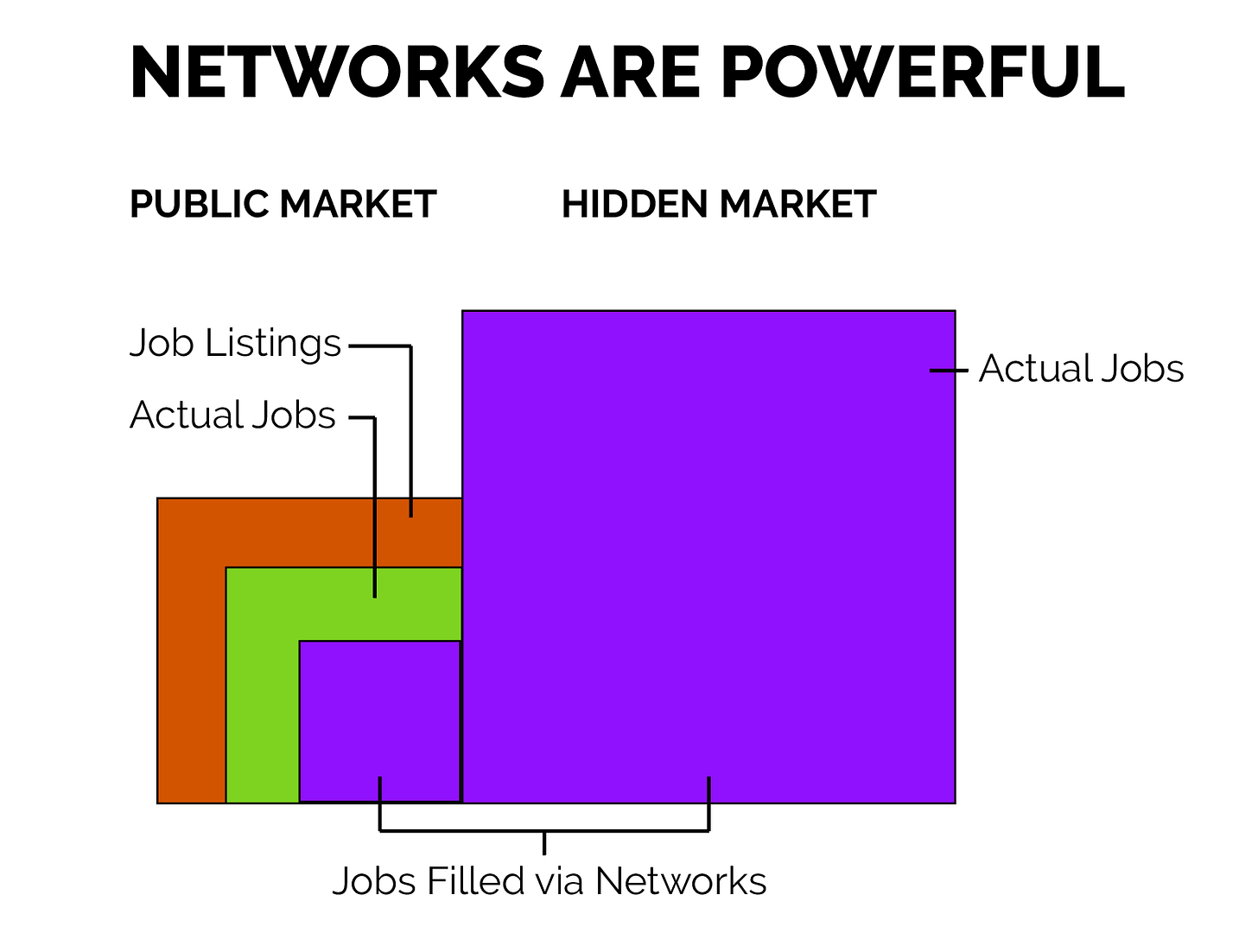Skip the Hiring Line
Stop Submitting Endless Applications and Learn to Get Hired in the Hidden Job Market
Finding a great job right now is tough. Really tough.
You probably know that already. You've filled out endless online applications, customized resumes to beat Applicant Tracking Systems (ATS), and faced the soul-crushing silence of being ghosted more than you'd like to admit. It messes with your head. Your sense of self-worth takes a huge hit, you feel out of place, and you find yourself wondering what is wrong with you.
You’re not broken. But you are looking in the wrong places.
Let’s see what we can do about that.
The Numbers Game
A recent iCIMS workforce report revealed that, on average, each tech or SaaS job posting attracts about 68 applicants. That hasn’t been my experience. When I was doing a lot of hiring in that space a couple years ago, it was normal to see 400+ applications for positions I was hiring for. After checking with a few friends still hiring there, it’s looking more like 800 now. The reality is clear: your odds in the traditional application game aren't great.
“A bad strategy repeated at scale doesn’t suddenly make it good”
But that's not the only issue. A substantial percentage of job postings—often referred to as "ghost jobs"—are not real opportunities at all. A staggering ResumeBuilder survey in 2024 revealed that 40% of companies had posted fake job listings within the last year, and 30% admitted to having active fake listings. Reasons vary, from giving the illusion of company growth to building a talent pipeline for future hiring or even trying to motivate current overworked employees by tricking them into believing that help is on the way (“hang in there!”) or that they’re easy to replace (“Get it done or you’re gone!”) I don’t think that’s gotten better this year.
So if you’ve heard something like, “It’s just a numbers game - submit enough applications and you’ll get hired eventually”— take that advice and throw it in the garbage. A bad strategy repeated at scale doesn’t suddenly make it good. Let me explain what I mean.
Most people seem to think that the hiring process is like a soup line, where you just have to wait your turn. People in the front of the line get their jobs, and everybody else takes a step forward.
That simply isn’t the case. People are constantly moving in and out of these applicant pools, and where you fall in line has nothing to do with how long you’ve been standing there. It comes down to how well your digital persona - your resume, skills, experience, and anything else you submit - stacks up against your competition.
Get A Competitive Edge Using AI - Just Like Everyone Else
“I’ve got a trick up my sleeve,” you say. “I’m going to optimize my resume using AI.” If you’re the one saying you’re going to do that, you’ve likely lost much of the available competitive advantage AI-optimized resumes may have once offered. A 2025 Study by ResumeNow found that 68% of job seekers use AI tools to write resumes, including keyword optimization, and 67% use them to craft personalized cover letters. So applicants are “optimizing” and collectively looking more and more alike.
In organizations, the hiring process is now dominated by AI-assisted technology designed to filter people out. Nearly 79% of organizations (and over 95% of Fortune 500 Companies) have integrated AI-driven screening into their ATS. That means your carefully crafted resume might be rejected before a human ever even gets the chance to review it. The system is flooded, inefficient, and broken, and AI is simultaneously making things better and much, much worse. (For a deep dive on this subject, I’ll shamelessly recommend my other post)
So far, this probably hasn’t been a super encouraging read. It’s a tough game to play, and it’s not going to get much easier. But what if you've been playing the wrong game altogether? What if the key to getting hired isn't about beating this system but sidestepping it entirely?
The Hidden Job Market
Here's a startling truth: about 70% of all job openings aren't posted publicly. They're filled through networking, internal referrals, and personal connections. Data from Apollo Technical and HubSpot shows that a whopping 85% of all roles are ultimately filled through networking.
This has absolutely been true in my own life. I’ve been fortunate to have an incredible career journey from NASA and nukes, to software and tech, to people and performance. I’ve made millions, met amazing people, and have learned more than I could have imagined. All without a single cold application. In my own experience hiring talent, I have reviewed somewhere between 7.5%-10% of applications I’ve received for my postings. If someone I trust hands me a resume and says, “you need to look at this person,” I look at 100% of those. I’m sure I’m not alone here.
Employers overwhelmingly prefer referrals and trusted connections for a few critical reasons:
Cost Efficiency: Posting job ads, processing hundreds of applications, and sorting through candidates is expensive and time-consuming. It’s a needle-and-haystack problem.
Trust: Candidates referred by trusted sources are viewed as inherently more reliable and culturally aligned.
Confidentiality: For sensitive roles or internal changes, companies prefer vetted, trusted channels.
Realizing where the real opportunities reside changes everything about your job search strategy. Instead of competing against hundreds of other anonymous applicants, your job search should center less around applications, and way more around relationships.
Shift Your Strategy
Here’s what you can do right now to start unlocking the hidden opportunities all around you.
1. Clarify Your Value and Your Message
The very first thing you must do is figure out who you are and what you bring to the table. Get clear about your unique skills, experiences, and the problems you’re best suited to solve. Then distill that clarity into one simple, powerful sentence: “I help [target audience] solve [specific problem] by [unique skill].” This statement becomes the cornerstone of every networking interaction.
2. Map Your Network (and Beyond)
You already have a network, even if it doesn't feel extensive. Make a list of everyone—friends, family, former colleagues, LinkedIn contacts, alumni, and community members. Don’t overlook second-degree connections. Warm introductions from mutual contacts are always preferable to cold outreach.
3. Gather Information
Instead of approaching people directly for jobs, seek advice. Reach out with sincerity: “I admire your work at [Company] and would love to learn more about your role. Could we chat for 15 minutes?” During these conversations, ask insightful questions, listen deeply, and genuinely engage. People love sharing advice when it feels authentic rather than transactional. And remember: you’re not looking for a job, you’re looking for insight and making new friends.
4. Make Your Asks Clear, Easy, and Balanced
Don’t be shy about explicitly stating what you're looking for, but do it respectfully and warmly: “Who do you know that might need the kind of help I can offer?” Remember to balance that with an offer to help them as well: “What’s one thing I can do to help you as well?” People appreciate directness paired with generosity.
The core mindset here is crucial: You're not chasing job postings—you're cultivating relationships. You’re offering value, not asking favors. This subtle shift changes the energy of your job search dramatically.
Do This Today
Reach out to one person in your network and request a short informational interview.
Update your LinkedIn headline and About section to reflect your unique value.
Find and help at least one person you know without any expectation in return.
It might seem daunting initially, but once you start focusing on relationships instead of online job postings, the entire game changes. Opportunities appear, doors open, and jobs that never see the public light become yours for the taking.
If you need help making that shift, the Mountainside team and I are here to help you with just that. Reach out, and let’s talk.
In Conclusion
You don’t need to fight the system to find great work. You need to step out of the broken system and into the thriving network of real humans all around you. There is a whole world of opportunity out there beyond the standard job boards. More real jobs, more people who have real needs for brilliant, talented people who want to do cool things that mean something. Those purple boxes in the figure above represent opportunity. It’s already there; it just needs to be unlocked. And my passion is giving people the keys for unlocking it.
If you want to dive deeper into this subject, don’t miss our free webinar.
References:
Apollo Technical. (2025). Networking statistics: How and why networking is important to your career. Apollo Technical LLC. Retrieved from https://www.apollotechnical.com/networking-statistics/
Clarify Capital. (2022). Study finds nearly one-third of job postings are fake. CompensationXL. Retrieved from https://www.compensationxl.com/study-finds-that-nearly-one-third-of-job-postings-are-fake/
Clarify Capital. (2025). 1 in 8 employers leave job postings open over four months without filling them. Clarify Capital. Retrieved from https://clarifycapital.com/job-postings-open-months-survey
Greenhouse. (2024). Greenhouse hiring trends report 2024: Ghost jobs. Greenhouse. Retrieved from https://www.greenhouse.io/blog/ghost-jobs-report-2024
HubSpot. (n.d.). 85% of jobs are filled through networking. HubSpot. Cited in Apollo Technical (2025). Retrieved from https://www.apollotechnical.com/networking-statistics/
iCIMS. (2025). March 2025 workforce report: Applicant volume and hiring trends. iCIMS. Retrieved from https://www.icims.com/resources/reports/march-2025-workforce-report/
Jobscan. (2024). Applicant tracking systems report 2024: Usage and trends among Fortune 500 companies. Jobscan. Retrieved from https://www.jobscan.co/blog/applicant-tracking-systems-report-2024/
ResumeBuilder. (2024). 3 in 10 companies currently have fake job postings listed. ResumeBuilder.com. Retrieved from https://www.resumebuilder.com/3-in-10-companies-currently-have-fake-job-posting-listed/
ResumeBuilder. (2024). Nearly 70% of employers use AI for screening job applications. HR Grapevine. Retrieved from https://www.hrgrapevine.com/us/content/article/2024-10-29-employers-increasingly-turning-to-artificial-intelligence-to-handle-recruitment-process
Select Software Reviews. (2025). Applicant tracking system statistics 2025: Usage, adoption, and industry trends. Select Software Reviews. Retrieved from https://www.selectsoftwarereviews.com/blog/applicant-tracking-system-statistics
Staffing Industry Analysts. (2023). Competition remains strong for tech job postings. Staffing Industry Analysts. Retrieved from https://www2.staffingindustry.com/Editorial/Tech-Job-Competition-2023
Zippia. (2023). Employee referral statistics. Zippia. Retrieved from https://www.zippia.com/advice/employee-referral-statistics/






